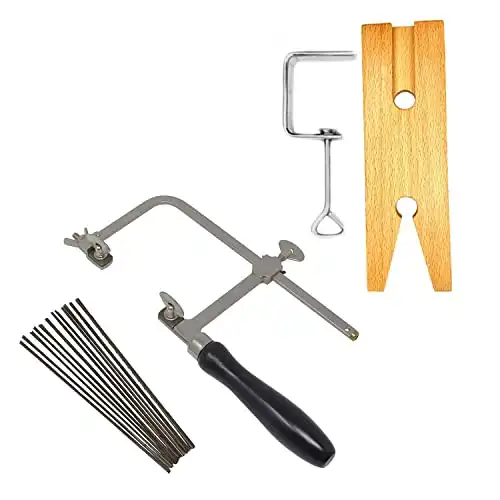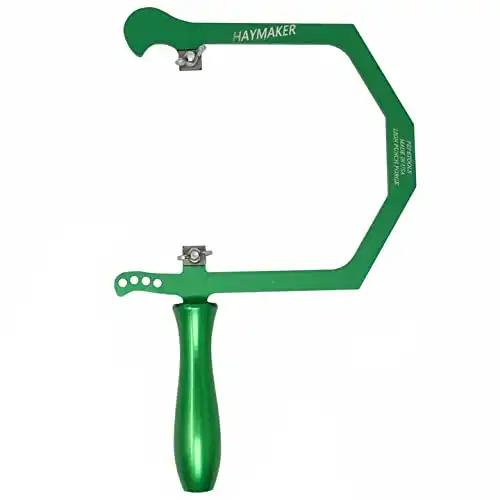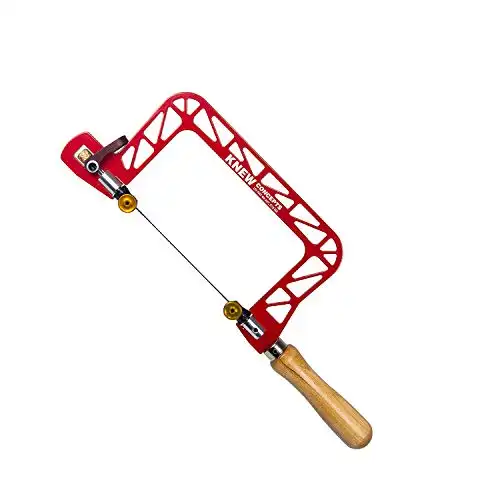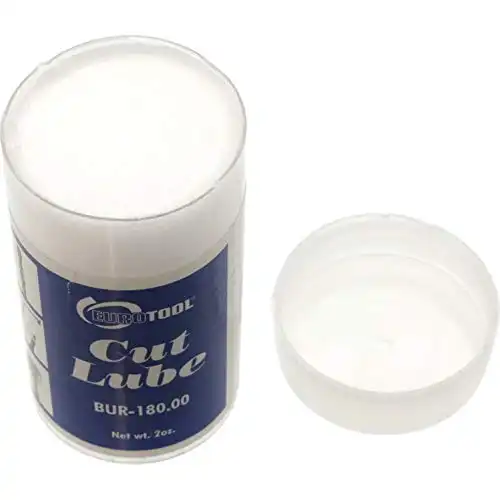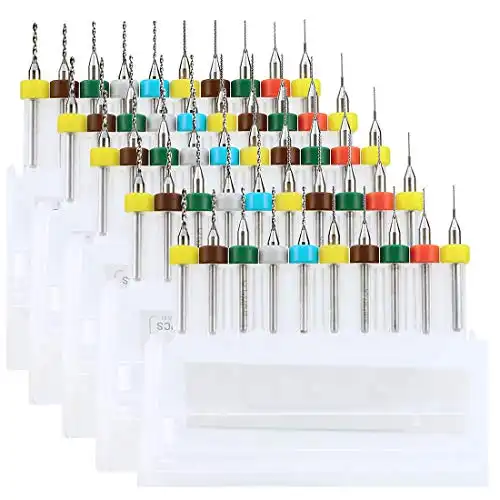The jeweler’s saw is one of the most important pieces of your silversmithing kit. It’s used for much more than just the occasional bit of cutting, and learning about them is critical to success. From blade choice to your grip, it’s all important to know.
So, let’s take a look into the world of the jeweler’s saw, starting with helping you find the right saw for your toolkit.
- Ultimate Guide To Learning Silversmithing On Your Own
- Basic Silversmithing Tools and Supplies For Beginners
Choosing a Jeweler’s Saw
Your sawing begins with choosing the right saw and blades. Let’s take a look at the saw first, but you should remember one simple thing while I show you some great examples: the best saw in the world won’t save you from bad blades.
Quick Recommendation For a Saw
I just picked a random kit to show you as an example. These cheap saws are readily available from most places, you can get started by going to somewhere like Michael’s this afternoon. These frames are all pretty much the same.
The only issue you may run into is some of these frames will tilt a bit when you’re putting tension on the saw. This usually tilts it a few degrees towards the handle from the top. They’re also a bit of a pain to tension, so breaking blades will break your workflow more.
These saws are cheap, readily available, and they will work. You can go through the generics available and see if you find a handle you’d like but they’ll hold tension, which is the important part. The only other big thing? The blades that come with these are usually trash.
Pros
- Cheap
- Readily available
- Can close to use broken blades
Cons
- Included blades are trash
- Blades may have a slight pitch with cheaper models
My personal saw is a red Pepe Tools Haymaker, and I can say the high price is worth it. The biggest thing is how convenient it is to change blades since it relies on physical tension. You bend the frame when locking the blade in, resulting in it being pulled tight in just a few seconds.
I’m also a big fan of the handle, which fits my hands pretty well. It’s definitely a more expensive tool than a standard German frame, however, and you won’t be able to use broken blade segments since there’s no sliding mechanism on the arch.
That said, it suits my needs just fine, and I haven’t regretted spending the money on it. The tool itself is well crafted, it’s easy to open and place the blade for piercing work, and it fits well in the hand.
Pros
- Well machined, lightweight frame
- Easy to tension and change blades
- Great handle
Cons
- Expensive
- Can’t use blade segments from broken blades
The Knew Concepts Jeweler’s Saw is something else. While the Haymaker is just a basic saw, perhaps with even fewer features than standard German frames, Knew Concepts has added a bunch of features that should improve your quality of life in exchange for a much higher price.
The saws come with slightly different features, but all of them allow tension adjustment on the fly. I prefer the cam-over system for locking the blade which is found on the high-end models. Those models also boast the ability to change the blade’s direction on a swivel.
Are they worth it? The answer is… maybe. The blade swivels amazed me when I first saw it… until I thought about how little use they are when actually sawing. Likewise, tension adjustment on the fly is pretty cool in theory but rarely used. It’s a great saw either way, and especially lightweight, but the added features are less useful than a beginner would think.
Pros
- Tons of extra features including a blade swivel
- Skeletonized aluminum frame for lighter weight
- Many versions available
Cons
- Very expensive
- Extra features are very, very niche in real-world use
What’s Important in a Jeweler’s Saw?
The only really important thing about your saw is that it holds proper tension and has a handle you can use under your bench pin. Everything else is pretty much window dressing, providing a bit of convenience in exchange for quite a bit of money.
The added convenience is nice, but many smiths use their cheap saws for years before they upgrade.
Still, the following list should help:
- Handle Ergonomics- Most have a similar handle, but some just end up feeling better than others. Grip is rarely an issue with your saw so look for a good palm swell instead of texture.
- Weight- Lighter saws are easier to use for longer periods of time. If you plan on doing intricate patterns for extended periods it’s a concern but the occasional 5-10 minute sawing session doesn’t need any special attention to this detail.
- Features- Features are great, but not necessary. I recommend learning with a cheap saw for a while, you’ll see why a lot of stuff that sounds awesome in theory ends up falling flat in practice.
- Throat Size- 3” is fine for the majority of at-home silversmithing work. Throat size will limit how deep you can cut on a sheet but 3”x3” is the standard size for buying silver sheets. Extensive piercing work (think brass lamps) may require a 5” throat.
The saw is important, but as long as it can hold the blade you’ll be good to go.
Order good blades when you get your first saw. The cheap blades that come with some saws will only frustrate you, and quality blades make a huge difference.
How to Choose the Right Blades
If you’re in a hurry, the short answer is to just buy a pack of 3/0 or 4/0 blades from a reputable brand and call it good. That’s 100% of my blade buying process, and it’s worked out for me this far.
That said, it’s not the best answer if you’re looking to optimize everything in your shop.
Finding Good Blades
You can find good blades through online retailers easily enough. Pike Jeweler, for instance, puts out some great blades at a decent price. They’re not the best on the market but they’re a massive improvement over the cheap blades that come with most saws.
Most jewelry supply houses have their own brand. Pepe Tools sells NANO blades, Rio Grande sells their Laser Gold blades, and these are all top of the line.
Saw blades make a much, much bigger difference in your sawing experience than you’ll find with upgrading your saw. I went from feeling like I couldn’t cut a straight line to handily cutting out complex shapes overnight when I upgraded my blades.
How Important is Having the Right Blade Size?
The general rule of thumb is to use a blade that leaves 2 teeth on the sides of what you’re cutting. In practical use, you can get away with a lot more. I use 4/0 blades for everything from slicing 2mm thick pieces of an ingot to cutting designs in 30 gauge sheets.
An oversized blade can make things a bit rougher, but it’s mostly just a matter of doing more finish work. If you’re looking for perfection, then match your blades and metal to a chart like this one.
Do I Need Anything Else?
You’ll need a few more things for easy sawing, but they’re not hard to get your hands on.
- Bench Pin- Bench pins are needed since we use a jeweler’s saw from underneath it. A lot of generic frames come with one, but you’ll need to find one if yours doesn’t. Or you can make your own with a drill and hacksaw by cutting a wedge into a big drilled hole.
- Lubricant- There are specially formulated waxes I’ll describe later, but you don’t have to use a purpose-made lubricant. 3-in-1 oil works fine, just make sure to wipe it off before heating a piece.
- Safety Glasses- The most unpredictable part of using a jeweler’s saw is the final cut. While some designs don’t have anywhere to go, when you cut things like thick-walled tubing or wire the ends can move in an erratic fashion. That can include coming right back into your eye, just wear the glasses.
The Basic Mechanics of Your Jewelers Saw
The jeweler’s saw is used differently than any other saw. You’re essentially trying to turn your hand and the saw into a low-speed bandsaw with an up-and-down movement.
It’s a lot easier if you keep the following tips in mind.
It’s All About Tension
Jeweler saw blades are very thin pieces of metal. You can’t use one to cut without it being properly supported in the saw.
The teeth of the saw should be raked back towards the handle when the blade is inserted. The tiny teeth can be hard to see, so a magnifying glass or loupe will help those without good close-up vision.
For that reason, good cutting starts as soon as you put the blade in. Unlike a hacksaw, you can’t just stick it in and let it go.
Standard German frames are usually sliding. You put the blade into both screws and then slide the top of the saw out until it’s tense before you fix the slide.
On the other hand, tension saws like the Haymaker require you to put the blade in on one end and tighten the screw. You then slip the blade into the loosened front nut and force one end of the saw to bend by pressing it against something (usually your sternum or belt buckle, but anything can work). Tighten the nut containing the loose front part of the blade while it’s bent and it will be at a good tension.
In any case, the saw blade should “sing” when you flick it. If the blade is too loose it won’t make a sound, when it’s too tight the blade usually ends up warped in some fashion.
If the blade isn’t tensioned correctly and inserted the right way you won’t be able to use the saw at all.
Getting the Right Grip
The saw’s handle should be underneath the bench pin while you’re cutting. That’s the reason the pin is usually at chest height in a professional workshop. Some of us just have to drop our chairs to get there, but the result is the same.
With the blade facing away from you, you’ll want to move the blade up and down in a directly vertical manner. The blade should be facing directly away from you.
Don’t get too tight on the handle. Your grip should be just tight enough to not let the saw move away from its position while you’re sawing into the material.
A big thing that you’ll have to get used to is not putting weight on the saw. Just let it cut at its own pace and you’ll get a smoother cut with less chance of breaking the blade. This is doubly important at the end of a cut, where you want to just maintain little pressure instead of pressing harder and causing the blade to break free too quickly.
That’s a recipe for breaking the blade.
Gently feeding the saw helps and is easy to figure out. If your saw is requiring a ton of pressure to cut… it’s time to change blades.
The Bench Pin
Any bench pin should do, and don’t be afraid to modify yours for your own use.
The bench pin needs to be attached to a sturdy workbench or desk. You’ll be surprised at how much force gets transferred to the furniture when you’re sawing, resulting in a bit of movement in less sturdy desks and benches.
Not everyone has a bench where they can set the pin to chest height. While that’s ideal, as long as you can work the saw you’ll be able to do just fine.
Lubrication
I prefer to use waxes when cutting over oils, but either works just fine. All you need is something that will let the blade slide more smoothly through the metal.
The wax lubricant I use, Cut Lube, is also usable for burrs used in a flex shaft. It’s the main reason I use it, but it also helps that it makes less mess than lubrication with oil. The other big reason is I constantly need oil for other equipment, so it lowers demand in the shop.
3-in-1 oil will work just fine as well. Simply put some on the piece where you plan to cut, then use your thumb and forefinger to run it along the blade.
Lubricant is essential to a good cutting experience. I resisted it for too long, which held back my progress, you’ll be amazed how much easier it is.
Cutting Curves and Corners
Cutting curves with the jeweler’s saw is a bit confusing for a newbie.
Remember my disdain for blade swivels from above? That’s because you don’t actually want to turn your saw if at all possible.
Instead, you turn the piece of silver around the blade while keeping it facing forwards. It takes a few tries to get it just right, but it’s pretty intuitive once you’ve been doing it for a while.
Turning the piece without moving the blade works well for gentle curves, but what about sharp corners?
In that case, you’ll need to quit “feeding” the saw for a moment and continue the up-and-down motion. Now, turn the piece in place without moving it forwards or backward. The teeth will remove a tiny amount of metal with each pass, allowing you to turn the metal in place without moving forward.
You can get some seriously sharp angles done this way. Practice is still key, as it’s easy to get the saw bound up when turning if you’re not careful.
Getting Into Piercing
Piercing is simple: you drill the metal and insert the blade through the piece and then re-tension the blade with your saw.
You’ll want to use the smallest bit you can to get through. A purpose-bought set like the one pictured below is the best idea, especially if you plan to move into very intricate designs.
You need to keep the silver off the blade as much as possible while re-tensioning. If you let it hang on the blade you’ll end up without enough tension to cut.
Securing Your Silver
If your saw isn’t cutting, you may have trouble with how secure your piece of silver is. Like filing, you need the metal to remain where you want it since any kind of flex or twisting reduces the cutting power of the blade.
With your saw, you can also warp a thinner sheet (26g or less) if you allow the metal to flex too much.
Keep in mind that a jeweler’s saw will cause lacerations if it hits your finger. I doubt you’ll need stitches, but the rough lacerations bleed for a while and really hurt. It’s not a fun experience.
But we need to be able to turn the workpiece, so we can’t just clamp the silver to the pin and call it good.
Instead, you’ll want to make sure you’re pressing down on the piece from both sides. You’ll greatly reduce your chances of getting cut if you come in from behind the blade and press down on either side. Both sides of the metal need to be supported and held in place for your saw to work.
I will just clamp a piece down for straight cuts on occasion.
In any case, the silver needs to be secure. The thinner the silver and the less metal on either side of the blade, the more important it is that the metal not move unless you’re moving it.
Try coming in as you see in the above picture to keep your fingers clear of the blade while keeping it secure.
Clean Up
Cleaning up cuts is usually quick.
If you’re using the 100% right saw blade size and good quality blades then you’ll rarely need to do much.
In general, a jeweler’s saw is always going to leave you with less clean-up work than using shears or cutters. Burrs are the main problem you’ll run into when you’re done with cutting a piece, but your saw will only leave minor ones. These can usually be knocked off with a needle file in no time.
Cleaning up interior cuts can be problematic, but there’s a simple way to be ready for it.
Back a piece of 400 grit sandpaper with duct tape, then cut it down halfway into thin strips. You can secure the uncut portion of the sandpaper in a vise and use the thin strips to clean up the interior.
That’s actually a very useful trick for those who make intricate pieces. It can be used across the board for any grit over 220 (lower grits are too stiff) and you can also use it for polishing cloths to get in tight crevices.
Transferring Patterns
Just writing with a Sharpie on silver or copper sheet metal doesn’t do much. Your fingers will rub it off in moments, even if you let it dry.
Transferring patterns, especially complex ones, can be a problem.
The method I use is simple: I print the pattern onto a shipping label sticker, then cut it out and put it directly on the metal. You can also use a glue stick to attach a pattern printed on normal paper.
If you have a well-ventilated workshop you can just burn the stickers off afterward. If not, cut down the center of the sticker with a razor blade and peel up the sides if it gives you trouble.
Rubbing alcohol or nail polish remover will get the glue off in no time, just use a bit of napkin or a cotton ball.
Scribes aren’t a bad idea to keep around. Mine rarely sees use, but when it does there’s nothing else that works quite as well.
There’s also a way to use acetone and a laser printer to transfer the design directly from the paper. While I don’t use this method, it’s easy to do and one of the best ways to easily transfer complex patterns to the metal without a giant headache.
Practice Ideas
Practice makes perfect with a jeweler’s saw, and it’s a tool I recommend actually practicing with. There are a few different ways to do this without breaking the bank.
Coin Practice
An old trick to keep apprentices busy (or just teach them to saw) is to practice with coins. I’ve seen it done most frequently with pennies.
The premise is simple, pick something on the coin to cut out (ie: Lincoln’s head on a penny), drill a hole, place the saw, and then cut it out. It’s simple, fast to set up, and often requires you to carefully cut out very fine details.
For those who are now clutching pearls over destroying money: this is perfectly legal.
The law specifies fraudulent destruction, mutilation, and other alterations. Artistic use or even just chopping them for fun is legal. The law was intended to keep people from changing denominations on bills and other borderline counterfeiting offenses, not to stop people from using coins in art.
Practice Patterns
The pattern I’ve used in the pictures above is a simple practice design I created with a graphic design program.
It’s intended to challenge the user a bit, with curves, tight corners, and some variety to keep from getting bored. You can get it here, and do whatever you’d like with it. I recommend sizing it at 1 ½” to 2” square for beginners.
Animal silhouettes are another one that I used frequently when I began sawing. Simple cats, dogs, or more exotic animals like elephants can all challenge your skills while providing you with a cute piece of metal at the end of the day.
Whatever you use, make sure to have some fun. Mastering the jeweler’s saw will take years, but the basics can be picked up in a weekend by those who are willing to learn!
- Online rock and mineral club for collectors of all levels!
- Find community with like-minded rock and mineral enthusiasts.
- Monthly Giveaways!
- Free Access to Entire Digital Library of Products (current and future products)*

